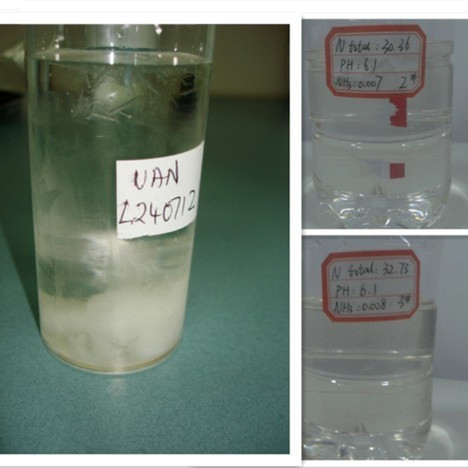Understanding Calcium Ammonium Nitrate
Calcium Ammonium Nitrate is a popular nitrogen fertilizer that contains both ammonium nitrate and calcium carbonate. The unique combination of these compounds makes Calcium Ammonium Nitrate (CAN) a versatile fertilizer suitable for a wide range of crops. The ammonium nitrate component provides readily available nitrogen, while the calcium carbonate contributes to soil health and structure.
1. Ammonium Nitrate Component
Source of Nitrogen: The ammonium nitrate in CAN serves as a crucial source of nitrogen for plants.
Quick Release: This component ensures a rapid release of nitrogen, making it readily available to crops.
Versatility: Rapid nitrogen availability is particularly important during key growth stages, such as germination and flowering.
2. Calcium Carbonate Component
Soil Health Enhancement: Calcium carbonate, the second key component, plays a vital role in improving soil health.
Nutrient Absorption: It contributes to better soil structure, enhancing the soil's ability to retain water and nutrients.
pH Regulation: Calcium carbonate helps regulate soil pH, reducing acidity and creating a more favorable environment for plant growth.
Benefits of Calcium Ammonium Nitrate for Crop Yield Improvement
Optimal Nutrient Balance
Calcium Ammonium Nitrate (CAN) provides a balanced ratio of nitrogen and calcium, addressing the essential nutrient requirements of plants. This balance promotes healthy growth, leading to increased yields. The nitrogen in CAN, in the form of ammonium nitrate, is readily available to plants. This is crucial for meeting the immediate nutrient demands during key growth stages. Ammonium nitrate ensures a rapid release of nitrogen, supporting the vigorous growth of plants. The quick availability of nitrogen makes CAN suitable for various crops with diverse nutrient requirements.
Quick Nitrogen Availability
The ammonium nitrate in Calcium Ammonium Nitrate (CAN) ensures a rapid release of nitrogen, making it readily available to plants. This quick availability is crucial during critical growth stages, such as germination and flowering. Ammonium nitrate readily dissolves in water, facilitating swift nutrient release into the soil solution. The dissolved nitrogen becomes rapidly available for plant uptake through the roots.
The quick availability of nitrogen makes CAN suitable for a diverse range of crops, as different plants have varying nutrient requirements during different growth stages.
Critical Growth Stages
Germination Phase:
Early Nutrient Supply: During the germination phase, seeds require a readily available source of nitrogen for the initial stages of growth.
Energy for Seedling Development: The quick release of nitrogen from CAN supports the energy needs of germinating seeds, promoting robust seedling development.
Flowering and Reproductive Phases:
Boosting Flower and Fruit Formation: The rapid availability of nitrogen is particularly crucial during flowering and reproductive stages when the demand for nutrients is heightened.
Optimizing Pollination and Fruit Set: Adequate nitrogen at these stages contributes to the development of healthy flowers, successful pollination, and improved fruit set.
Soil Health Enhancement
The calcium carbonate component of Calcium Ammonium Nitrate (CAN) not only acts as a nutrient but also contributes to soil health. It improves soil structure, reduces acidity, and enhances nutrient absorption by plants.
Calcium carbonate aids in the formation of soil aggregates, leading to improved soil structure. Enhanced soil structure promotes better aeration and water infiltration, creating an environment conducive to root growth. The presence of calcium carbonate helps mitigate soil compaction, preventing the soil particles from becoming too tightly packed. Reduced compaction facilitates easier root penetration and expansion, allowing plants to access nutrients and water more efficiently. Calcium carbonate has alkaline properties, which can help neutralize soil acidity. It contributes to maintaining a balanced soil pH, creating a more favorable environment for plant growth. The buffering capacity of calcium carbonate helps prevent rapid changes in soil pH, stabilizing the acidic conditions that may negatively impact plant growth. A balanced pH range enhances the availability of essential nutrients to plants. The carbonate component acts as a natural neutralizer of soil acids. This neutralization process leads to a reduction in soil acidity, creating a more suitable environment for plant root activity.
In regions with naturally acidic soils, or where acidity has developed due to certain agricultural practices, the application of CAN can help alleviate these conditions.
The improved soil structure and pH regulation facilitated by calcium carbonate contribute to better nutrient solubility.
Efficient Nutrient Absorption: This, in turn, enhances the absorption of essential nutrients by plant roots, promoting healthy growth.
Calcium carbonate has the ability to bind with certain toxic metals, reducing their availability to plants. This immobilization helps in minimizing the potential environmental impact of toxic elements.
The calcium carbonate component in Calcium Ammonium Nitrate plays a multifaceted role in soil health enhancement. From improving soil structure and reducing acidity to regulating pH and enhancing nutrient availability, these contributions collectively create a more conducive environment for plant growth. CAN's impact on soil health extends beyond its role as a fertilizer, making it a valuable tool for sustainable agriculture.
Reduced Nitrogen Loss
CAN's composition minimizes nitrogen loss through volatilization or leaching, ensuring that a significant portion of applied nitrogen is utilized by the crops. The ammonium nitrate in CAN provides a stabilized form of nitrogen. This controlled-release mechanism minimizes the risk of rapid nitrogen loss after application. The composition of CAN minimizes the conversion of ammonium to ammonia gas, thereby reducing volatilization losses. This reduction in ammonia emissions contributes to environmentally friendly and sustainable fertilizer application practices.
Low volatilization ensures that the applied nitrogen remains in a form that is available to plants, retaining its nutrient value. The reduced loss of nitrogen to the atmosphere means more nitrogen is available for plant uptake, optimizing nutrient utilization.
Improved Crop Quality
The balanced nutrition provided by Calcium Ammonium Nitrate (CAN) not only increases yield but also enhances the quality of the harvested crops. This is particularly crucial for crops intended for human consumption. The balanced nutrient supply supports robust vegetative and reproductive growth, contributing to increased overall crop yield. Adequate nitrogen promotes chlorophyll production, enhancing the efficiency of photosynthesis, which, in turn, contributes to higher yields.
The balanced nutrition provided by CAN results in crops with a higher nutrient content, making them more nutrient-dense. Improved nutrient uptake contributes to better flavor, texture, and overall palatability of the harvested produce.
Best Practices for Using Calcium Ammonium Nitrate (CAN)
Appropriate Application Rates
Farmers should follow recommended application rates based on crop type, soil conditions, and local agricultural guidelines to achieve optimal results. Different crops have distinct nutrient requirements at various growth stages. Recommended application rates for CAN take into account the specific nutrient needs of different crops, ensuring that each receives the necessary nutrients in appropriate amounts. Some crops may be sensitive to excessive nutrient levels. Following recommended rates helps prevent over-application, reducing the risk of nutrient imbalances or toxicity.
Soil nutrient levels can vary, and understanding the existing nutrient content is essential. Recommended application rates consider existing soil conditions, allowing farmers to balance nutrient deficiencies and avoid excessive accumulation.
Soil texture and structure impact nutrient availability to plants. Application rates may be adjusted based on soil characteristics to optimize nutrient absorption by plants.
Local agricultural guidelines often include regulations regarding fertilizer application to minimize environmental impact. Following recommended rates helps prevent excessive runoff, reducing the risk of nutrient contamination in water bodies.
Local guidelines may provide specific recommendations based on regional climate conditions.
Minimizing Environmental Stress: Adapting application rates to local climate considerations helps minimize environmental stress on crops.
Modern farming practices often involve precision agriculture, where nutrient application is tailored to specific areas of a field. Following appropriate rates ensures that nutrients are applied precisely where needed, reducing wastage and optimizing resource use efficiency.
Advanced technologies such as soil sensors and satellite imagery are used to monitor nutrient levels. Farmers can dynamically adjust application rates based on real-time data, maximizing the effectiveness of nutrient delivery.
Following recommended application rates allows farmers to conduct a cost-benefit analysis, maximizing the return on investment. Avoiding excessive application helps optimize the use of fertilizers, reducing unnecessary costs.
Appropriate application rates contribute to minimizing the risk of nutrient runoff, leaching, and environmental pollution. Following guidelines supports sustainable farming practices, promoting long-term soil and environmental health.
Following appropriate application rates for Calcium Ammonium Nitrate is a fundamental aspect of successful and sustainable agriculture. Tailoring nutrient application to crop types, soil conditions, and local guidelines helps achieve optimal results, ensuring efficient nutrient utilization, environmental responsibility, and economic viability for farmers. By adhering to these recommended rates, farmers can contribute to the overall health and productivity of their crops while minimizing potential negative impacts on the environment.
Timely Application
Timing is crucial when using Calcium Ammonium Nitrate (CAN). Applying the fertilizer at key growth stages ensures that crops receive the necessary nutrients when they are most needed. The ammonium nitrate component of CAN ensures a rapid release of nitrogen, making nutrients readily available to plants. Timely application addresses the immediate nutrient requirements of crops, especially during critical growth phases. Applying CAN at key growth stages helps prevent nutrient deficiencies, which can stress plants and negatively impact yield and quality. Timely nutrient supply ensures that crops have access to the nutrients they need for optimal uptake and utilization.
Integration with Other Practices
Integrating Calcium Ammonium Nitrate (CAN) with other sustainable farming practices, such as crop rotation and cover cropping, can further enhance its effectiveness in improving crop yields.
Integrating CAN with crop rotation helps maintain soil health by preventing the continuous cultivation of the same crop, which can deplete specific nutrients. Different crops have varied nutrient demands. Crop rotation allows for the diversification of nutrient requirements, optimizing the use of CAN for specific crops at different times. Integrating CAN into a crop rotation plan ensures a balanced nutrient supply tailored to the needs of each crop in the rotation cycle.
CAN, when integrated with cover cropping, contributes to maintaining soil structure and preventing nutrient runoff.
Integrating CAN with cover crops that fix nitrogen can reduce the reliance on external nitrogen sources, promoting sustainable nutrient management.
CAN, when applied in conjunction with cover crops, supports the breakdown of organic matter, releasing nutrients and further promoting soil fertility.
The addition of organic matter from cover crops fosters a healthy microbial community in the soil. Beneficial microbial interactions facilitated by cover crops can enhance the efficiency of nutrient uptake from CAN.
Integrating CAN with cover crops contributes to improved water use efficiency, reducing water stress on main crops. The combination of CAN and cover crops can improve overall root health and resilience, making crops more resistant to periods of drought. Integrating both practices promotes sustainable water management in agriculture.
Cover crops create habitats for beneficial organisms, including pollinators and natural predators of pests. A diverse ecosystem, encouraged by cover crops, supports a balanced interaction of organisms that can positively impact crop health.
The presence of beneficial organisms fostered by cover crops can contribute to natural pest control. A reduced need for chemical pesticides aligns with sustainable farming practices, promoting environmental health.
Farmers integrating CAN with other sustainable practices can serve as models for sustainable agriculture. Sharing experiences and knowledge with the local community fosters awareness and understanding of sustainable farming practices.
Integrating Calcium Ammonium Nitrate with other sustainable farming practices enhances its overall effectiveness in improving crop yields. The synergy with practices such as crop rotation and cover cropping not only maximizes the benefits of CAN but also promotes a holistic and sustainable approach to agriculture. This integrated approach contributes to soil health, water use efficiency, biodiversity, and community engagement, aligning with the principles of sustainable and environmentally conscious farming.
Conclusion
In conclusion, Calcium Ammonium Nitrate stands out as a valuable tool for farmers looking to maximize crop yields. Its balanced nutrient composition, quick nitrogen availability, and positive impact on soil health make it a preferred choice in modern agriculture. By adopting best practices and incorporating Calcium Ammonium Nitrate (CAN) into their fertilization strategies, farmers can contribute to sustainable and productive crop production for the growing global population.



